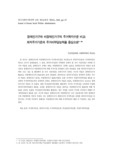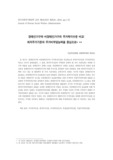

PARTNER
검증된 파트너 제휴사 자료
장애인가구와 비장애인가구의 주거복지수준 비교: 최저주거기준과 주거비부담능력을 중심으로 (Comparing Levels of Housing Welfare between Households with Disabled Members and without Disabled Members: Focusing on Minimum Standards of Housing and Housing Affordability)
27 페이지
최초등록일 2025.02.11
최종저작일
2010.06

-
서지정보
· 발행기관 : 한국사회복지행정학회
· 수록지 정보 : 한국사회복지행정학 / 12권 / 2호 / 1 ~ 27페이지
· 저자명 : 이선우
초록
본 연구는 장애인가구와 비장애인가구의 주거복지수준을 비교하고자 최저주거수준과 주거비부담능력으로 나누어 살펴보았다. 그 결과, 최저주거기준의 주택설비 중에서 한 가지 시설이라도 미비한 가구의 비율을 보면, 장애인가구 중에는 9.9%, 비장애인가구 중에는 6.2%로 장애인가구의 비율이 높게 나타나 장애인가구가 비장애인가구에 비해 주거시설 충족률이 낮게 나타났다. 또한 최저주거기준의 주택의 구조ㆍ성능 및 환경에서 한 가지 기준이라도 충족시키지 못하는 가구의 비율은 장애인가구가 38.4%로, 비장애인가구의 33.6%보다 높게 나타났다. 결과적으로 최저주거기준을 충족하지 못하는 가구의 비율은 장애인가구 47.3%, 비장애인가구 42.8%이었다. 또한 주거비가 적정주거비부담률 30%를 초과하여 주거비부담능력을 충족하지 못하는 장애인가구의 비율은 15.2%, 비장애인가구는 11.1%로 장애인가구의 비율이 더 높았다. 한편 특성감안가격모형을 활용하여 가구의 주거특성을 고려하여 추정한 최저주거비부담률이 30%를 초과한 장애인가구의 비율은 35.7%로 비장애인가구의 22.8%에 비해 약 13.0% 포인트 높았다. 특성감안가격모형을 활용하는 경우 적정한 수준의 주거에 거주하기 위해서 주거비부담률이 30%를 넘는 가구의 비율은 장애인가구와 비장애인가구 모두 상승하지만 특히 장애인가구와 비장애인의 격차가 커진다. 이는 장애인가구가 개별가구의 주거특성을 감안한 최저주거기준을 충족시키는 주거에 거주하기 위해서는 비장애인가구에 비해 주거비부담이 훨씬 더 커진다는 것을 의미한다.영어초록
This study analyzed minimum standards of housing and housing affordability to compare levels of housing welfare between households with disabled members and without disabled members. The proportion of the households with disabled members which did not meet the minimum standards of housing was 47.3%, while the proportion of the households without disabled members was 42.8%. Concerning housing affordability, the proportion of the households with disabled members which spent more than the appropriate housing cost-to-income ratio(30%) was 15.2%, while the proportion of the households without disabled members was 11.1%. In addition, appropriate minimum housing cost-to-income ratios were estimated to consider housing attributes of households by using the hedonic price model. The proportion of the households with disabled members of which the estimated minimum housing cost-to-income ratio was over 30%, was 35.7%. It was 13.0% point higher than that of the households without disabled members, 22.8%. The estimated minimum housing cost-to-income ratios by the hedonic theory were much higher than the real housing cost-to-income ratios. Moreover, the difference between the households with disabled members and without disabled members was bigger with the hedonic theory. It means the housing cost burden of the households with disabled members will become bigger than that of the households without disabled members when the households try to reside in houses which meet each household's housing attributes and the minimum standards of housing. In conclusion, the levels of housing welfare of the households with disabled members were lower than those of the households without disabled members.참고자료
· 없음태그
-
자주묻는질문의 답변을 확인해 주세요

꼭 알아주세요
-
자료의 정보 및 내용의 진실성에 대하여 해피캠퍼스는 보증하지 않으며, 해당 정보 및 게시물 저작권과 기타 법적 책임은 자료 등록자에게 있습니다.
자료 및 게시물 내용의 불법적 이용, 무단 전재∙배포는 금지되어 있습니다.
저작권침해, 명예훼손 등 분쟁 요소 발견 시 고객센터의 저작권침해 신고센터를 이용해 주시기 바랍니다. -
해피캠퍼스는 구매자와 판매자 모두가 만족하는 서비스가 되도록 노력하고 있으며, 아래의 4가지 자료환불 조건을 꼭 확인해주시기 바랍니다.
파일오류 중복자료 저작권 없음 설명과 실제 내용 불일치 파일의 다운로드가 제대로 되지 않거나 파일형식에 맞는 프로그램으로 정상 작동하지 않는 경우 다른 자료와 70% 이상 내용이 일치하는 경우 (중복임을 확인할 수 있는 근거 필요함) 인터넷의 다른 사이트, 연구기관, 학교, 서적 등의 자료를 도용한 경우 자료의 설명과 실제 자료의 내용이 일치하지 않는 경우
“한국사회복지행정학”의 다른 논문도 확인해 보세요!
-
지역자활센터 실무자들의 자활사업 참여자들에 대한 인식 유형 21 페이지
이 연구의 목적은 지역자활센터 실무자들의 자활사업 참여자들에 대한 인식 유형을 파악하고, 유형별 특성을 토대로 참여자 및 실무자들을 위한 교육형태나 내용에 대한 방향을 제시하는 것이다. 자활사업 참여자와 관련하여 엄선된 27개의 진술문을 가지고 11명의 지역자활센터 실무자들을 대상으로 Q 분류를 하게 하였다. Q 방법론을 통해 지역자활센터 실무자들의 참여자.. -
사회복지기관 윤리경영 자가점검지표 개발에 관한 연구 41 페이지
최근 시대적, 환경적 변화에 따라 우리 사회 전반에서 윤리경영에 대한 관심이 고조되면서, 전통적으로 윤리를 주요 덕목으로 삼아온 사회복지에서도 윤리경영을 본격적으로 도입하여 확산해 가고 있다. 이러한 움직임이 보다 견고한 구조와 체계성을 갖추기 위해서는 각 기관이 윤리경영의 수준을 평가하고 점검할 수 있는 도구의 개발이 필요하다. 이에 본 연구는 사회복지기.. -
사회복지의 책임성 변화에 대한 비판적 고찰 26 페이지
본 연구의 목적은 최근 사회복지현장에서 적용되고 있는 소위, ‘새로운 책임성’(New Accountability)이 과연 사회복지서비스의 전달에서 발생될 수 있는 문제가 있는지를 검토하고, 이러한 책임성의 변화의 현실적 적용과 관련된 우리나라의 기존 연구들은 어떻게 진행되어 왔는지를 비판적 시각에서 고찰해 보는 것이다. 현재의 사회복지 책임성은 전통적 책임..
찾으시던 자료가 아닌가요?
지금 보는 자료와 연관되어 있어요!
문서 초안을 생성해주는 EasyAI




